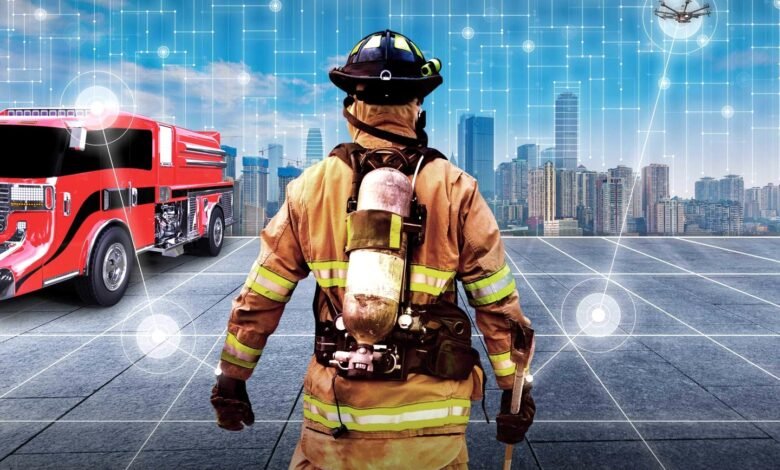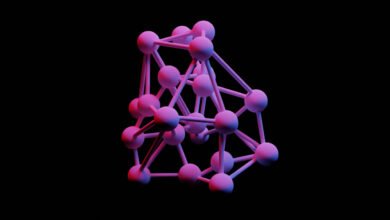
The Internet of Things (IoT) improves safety in hazardous areas, such as firefighting, by linking devices that provide real-time data and facilitate seamless communication. Firefighters equipped with IoT-enabled equipment can monitor their vital signs, determine their location, and receive real-time updates on environmental conditions. These traits enhance their ability to navigate dangerous situations with greater efficiency.
Relevant information is essential in critical situations. It empowers commanders to make rapid choices, modify strategy, and facilitate prompt evacuations as necessary. This continuous influx of information improves situational awareness, optimises operations, and renders firefighting safer and more effective.
IoT for Firefighters
#1: Wearable Sensors for Health Monitoring
Wearable gadgets monitoring vital signs, such as heart rate and body temperature, are increasingly essential for responder safety. In 2022, more than 65,000 firefighters injuries were reported in the line of duty, underscoring the necessity of real-time health monitoring. These intelligent sensors continuously monitor a firefighter’s physiological state and notify command centres if any anomalies are detected.
In the case of a heart rate spike or too elevated body temperature, the sensors provide alarms, facilitating prompt actions that can avert significant harm. This degree of protection enables wearable technology to enhance safety for authorities during high-risk procedures.
#2: Gas and Air Quality Sensors
IoT sensors that identify hazardous concentrations of carbon monoxide and other detrimental gases are essential for ensuring the safety of firefighters against unseen threats. These gadgets incessantly assess air quality and detect hazardous contaminants. Upon detecting harmful levels, the sensors promptly notify authorities and command centres to assure awareness of the hazard.
This feature enables responders to evacuate or implement required safeguards prior to the situation escalating. Disseminating air quality data mitigates the risk of respiratory ailments and chronic health consequences resulting from exposure to deleterious gases.
#3: IoT-Enhanced Firefighting Training Simulators
IoT-based simulations enhance firefighter training by generating extremely realistic, immersive scenarios that address the skills deficit resulting from retiring firefighters. In light of manpower shortages within public safety agencies, these simulators offer recruits practical experience.
Real-time data from sensors and IoT devices enables the simulation of authentic fire conditions, encompassing heat levels, air quality, and building configurations. This enables learners to engage in practice within realistic situations in a secure, regulated environment.
Firefighters can utilise this sophisticated, data-informed training to enhance their readiness and response efficiency. It prepares people to manage emergencies with enhanced confidence and proficiency.
#4: Connected Firefighting Vehicles
The integration of IoT in fire engines and emergency vehicles optimises route planning and guarantees that equipment is consistently prepared for deployment. Teams can utilise data to determine the most expedient and secure path to the location, circumventing traffic and hazardous zones. IoT sensors also assess vehicle performance and equipment condition to guarantee optimal functionality before to arrival.
Firefighters receive real-time updates on fire conditions while in route, providing them with essential information for preparation and strategy. This advanced technology enhances efficiency and guarantees that authorities are adequately prepared to respond upon arrival.
#5: Drone Surveillance
Drones driven by IoT improve firefighting by providing aerial monitoring in emergencies. Enhanced obstacle identification skills enable efficient navigation of rough terrain, becoming them indispensable in inaccessible areas.
While in flight, they furnish responders with real-time information regarding fire propagation, structural integrity, and possible dangers. This knowledge enables teams to make expedited, well-informed decisions, facilitating more precise strategising and response to the circumstance. The utilisation of drones augments safety and promotes overall firefighting efficacy.
#6: GPS-Enabled Location Tracking
Real-time monitoring of authorities during emergencies is crucial for safety and efficacy. NASA and the Department of Homeland Security have created a device that can pinpoint firemen within a 70-meter radius of emergency vehicles outside the structure. This functionality enables command centres to oversee their personnel in intricate and perilous settings.
IoT technologies can monitor each firefighter’s actions and modify their strategy depending on real-time data. This facilitates enhanced collaboration, expedited responses to evolving circumstances, and more informed decision-making. The capability to monitor the real-time locations of all responders mitigates hazards and enhances overall emergency response operations.
#7: Smart Hydrant Systems
IoT technology enables fire hydrants to connect to centralised systems, delivering real-time data on water flow and availability. This guarantees that firefighters obtain precise water supply information prior to arriving at the scene, facilitating more effective planning.
Continuous surveillance of water pressure and flow mitigates the likelihood of equipment malfunction and guarantees that rescuers have access to a reliable supply during critical moments. This understanding enables teams to face emergencies with confidence, assured that one of their most vital resources is consistently prepared and reliable.
#8: Thermal Imaging Cameras for Visibility
IoT-connected thermal cameras are beneficial for firefighters as they enable visibility through dense smoke and facilitate safer navigation in hazardous settings. These cameras identify thermal signatures, enabling responders to discover individuals, hotspots, and escape routes in low-visibility or smoke-laden environments.
In 2022, eight firefighters sadly perished after becoming ensnared in debris, highlighting the imperative for enhanced visibility during crises. Improving visibility in otherwise obscured settings mitigates the risk of injury. It provides authorities a significant edge when speed and safety are critical.
The Future of the IoT in Emergency Services
The future of IoT technologies in emergency services presents significant potential, as they provide intelligent, real-time solutions that improve safety, efficiency, and decision-making. As these innovations advance, they will safeguard first responders and the communities they serve.











